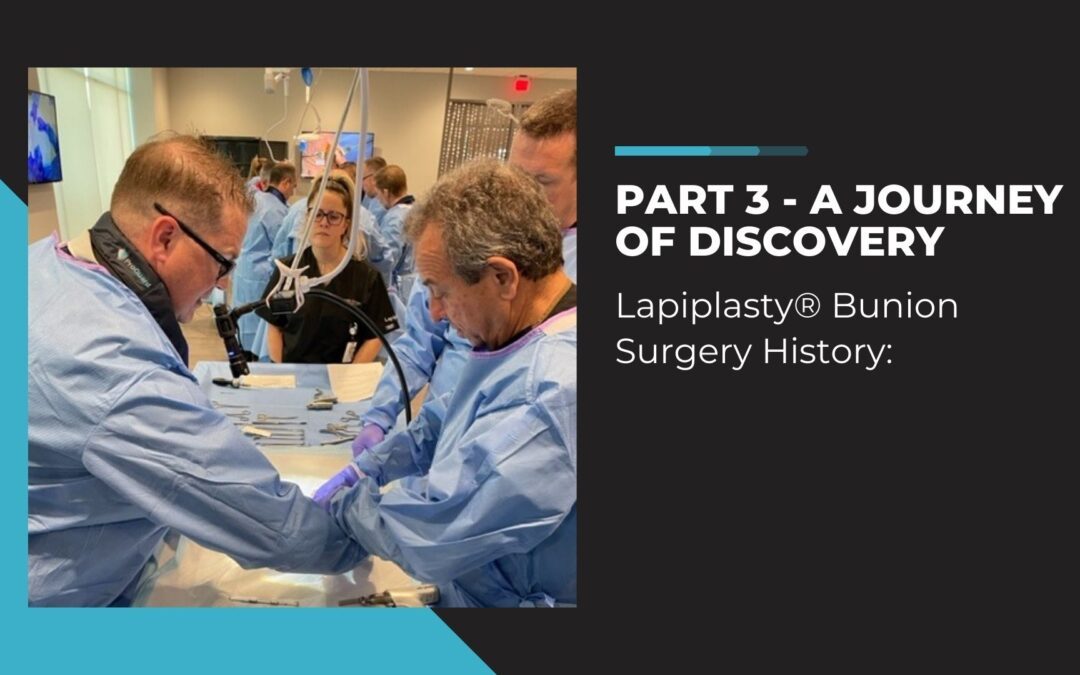The Journey of Discovery: Doubt, Support, and Breakthrough
With all medical innovation, the path to discovery is often laid with challenges and skepticism. Challenges and skepticism were certainly the themes as Dr. Santrock and the Treace research team embarked on their journey to redefine bunion surgery. The goal was clear: to address the inadequacies of traditional bunion surgery techniques and offer a solution that could benefit the 400,000 patients undergoing bunion surgeries annually. Unfortunately, the path was not as straightforward as one would hope to develop Lapiplasty® Bunion Surgery.
To learn more about the origins of the Treace Lapiplasty team, read part 1 of our Lapiplasty® Bunion Surgery History series.
Skepticism and the Quest for a Solution | Lapiplasty® Bunion
Despite the recognized need for improving traditional bunion surgery, doubt clouded the initial stages of the development of Lapiplasty®. Traditional approaches to bunion surgery were deeply entrenched, and the task of overhauling them was daunting. The issues were multifaceted: skill-based limitations, complexities in treating bunions at multiple locations, rotational problems, and the critical need for immediate weight-bearing post-surgery.
Everyone on the development team harbored some reservations. Identifying the problem was one thing; finding a viable solution was another. The early days of Lapiplasty® Bunion Surgery were fraught with more questions than answers, leading to an atmosphere of skepticism among the surgeons involved.
The Role of Family: A Source of Reassurance and Motivation
In these moments of doubt, the support system becomes paramount. For Dr. Santrock, this support came from his family, particularly his wife. Her belief in the mission, and more importantly, in the capabilities of Dr. Santrock and his colleagues, provided a much-needed anchor. She reminded him of the significance of their work, not just for the medical community but for the countless families and individuals who could benefit from a medical breakthrough.
In moments where the weight of the task seemed insurmountable, she was there to offer words of encouragement and perspective. She understood the implications of their work – it wasn’t just about rewriting chapters in medical textbooks; it was about touching lives, about providing a ray of hope to those suffering from the debilitating effects of bunions. Her belief was not rooted in naive optimism but in a deep understanding of the transformative impact their success could have.
Reenergizing Through Collaboration and Discovery of Lapiplasty® Bunion Surgery
For Dr. Santrock and his team, progress entailed delving into the complexities of medical-grade hardware and the new techniques of surgery. As they ventured deeper into these discussions, their meetings evolved into dynamic brainstorming sessions, buzzing with ideas and possibilities.
Initially, these sessions seemed to open Pandora’s box, revealing a multitude of new challenges and complexities. Each revelation of a problem brought with it a sense of being overwhelmed, but it also carved out space for creative problem-solving. As the team grappled with these challenges, a remarkable transformation began to take place. The overwhelming nature of the problems started to give way to a tide of potential solutions. Each obstacle encountered paved the way for innovative thinking and collaboration, turning setbacks into stepping stones towards progress.
It was during these intense periods of collaboration that Dr. Santrock’s wife observed a significant shift in his energy and demeanor. Where there was once a sense of frustration, a new kind of enthusiasm began to emerge. She noted that the frustrations, far from being a sign of defeat, were actually indicative of the groundbreaking nature of their work. Each hurdle they encountered and overcame added to the collective energy of the team, fueling their passion and drive.
This reenergizing process was not just about finding solutions; it was about the synergy of minds coming together, each bringing their unique perspective and expertise to the table. The discussions were no longer just technical debates but had transformed into a symphony of creative and analytical thinking. The fusion of diverse knowledge in medical-grade hardware and robotics with the clinical expertise of the surgeons created a fertile ground for innovation.
Dr. Santrock’s wife’s insight was pivotal in this phase. By recognizing the positive aspects of what appeared to be setbacks, she helped Dr. Santrock see the bigger picture. The frustration was not a signal that they were on the wrong path, but rather, a natural part of the journey towards a significant medical breakthrough. Her perspective provided a much-needed morale boost, reminding the team that groundbreaking work often comes hand-in-hand with challenges and that overcoming these challenges is what leads to true innovation.
From Problems to Solutions: The Turning Point
The turning point came in the summer of 2015, about 13 to 14 months into the project. After countless workshops, discussions, and trials involving over 270 cadavers and 25 labs, the team had a eureka moment. They had developed a formula, a breakthrough in their quest to revolutionize bunion surgery. However, this formula was just the beginning. The real challenge lay ahead – transforming this theoretical breakthrough into a practical, repeatable surgical procedure.
The Dawn of a New Surgical Era
As Dr. Santrock and his team stood on the precipice of this medical revolution, the question loomed: How would they translate their hard-earned knowledge into a successful surgical technique? The journey from a formula to a fully developed surgical procedure was another step, a challenge that beckoned with both promise and uncertainty.
Read PART 4 in this remarkable journey of medical innovation and human perseverance.
READ PART 1 of Lapiplasty® Bunion Surgery History | READ PART 2 of Lapiplasty® Bunion Surgery History

